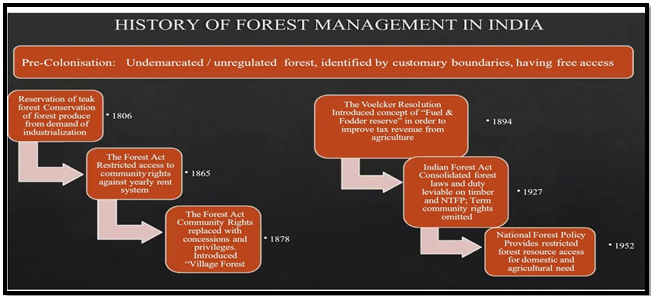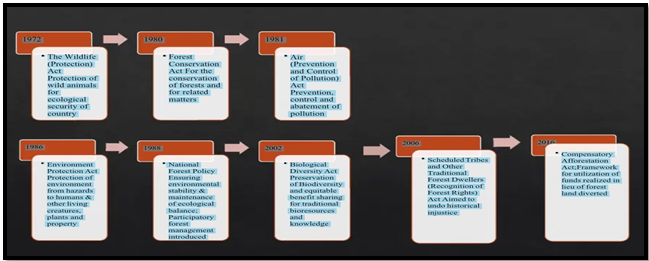UPHILL BATTLE FOR FOREST RIGHTS ACT IMPLEMENTATION
Syllabus:
GS2: Issues related to Development , Issues related to SC-ST.
Issue In Focus:
- Forest Rights Act (FRA) enacted in 2006 by the Lok Sabha aims to address socio-environmental conflicts and democratize forest governance.
- Despite its potential, FRA’s implementation faces challenges, including political opportunism, forester resistance, and bureaucratic apathy.

Source: Scribd
Historical Injustices:
- Pre-colonial era:
- Local communities had customary rights over forests.
- Colonial takeover disrupted traditions, imposing unjust policies, such as the Indian Forest Act (IFA) of 1878.
- Indian Forest Act 1878 denied the right to customary use of forest resources and land to villagers.
- Post-Independence:
- Princely States’ forest areas declared state property without proper inquiry, leading to the displacement of legitimate residents.
Impact of Colonial Forest Policy :
- Ban on shifting cultivation.
- Incomplete survey and settlement favouring the state.
- Creation of “forest villages” with compulsory labour.
- Restricted and controlled access to forest produce.
- No right to manage forests, resulting in overexploitation.
The Forest Rights Act 2006
The Forest Rights Act 2006 (FRA 2006) also known as Scheduled Tribes and Other Traditional Forest Dwellers ( Recognition of Forest Rights) Act stands as a crucial legislation designed to protect the rights of forest-dwelling tribal communities and ensure sustainable forest management.
Background of FRA 2006:
- The FRA 2006 emerged as a response to historical injustices caused by colonial-era forest laws.
- Prior laws prohibited local communities, particularly scheduled tribes, from utilizing forest resources.
- The FRA, enacted in December 2006, aimed to correct these wrongs by granting legal recognition to the rights of traditional forest-dwelling people.
Key Features and Provisions:
Objectives:
- Correct historical wrongs done to forest-dwelling communities.
- Guarantee land tenure, livelihood, and food security for scheduled tribal communities.
- Strengthen the forest conservation framework through sustainable usage.
Individual and Community Rights:
- Recognition of individual rights such as self-cultivation and habitat.
- Acknowledgment of community rights, including grazing and fishing.
- Access to naturally distributed water bodies and habitat rights for vulnerable tribal groups.
Forest Management Rights:
- Empowers communities to defend, regenerate, preserve, and manage community forest resources sustainably.
- Focuses on the sustainable coexistence of forest-dwelling communities and conservation efforts.
Importance of the Forest Rights Act:
- Acknowledgment of Community Rights:
- Recognition of shared or common property resources (CPR) for the first time.
- Assurance of livelihood and food security for forest dwellers.
- Conservation and Sustainable Usage:
- Supervision and preservation of community resources to protect traditional links with forests.
- Protection of intellectual property and traditional knowledge systems.
- Expansion of Constitutional Safeguards:
- Extension of the 5th Schedule and 6th Schedule of the Indian Constitution to protect indigenous communities.
- Empowerment of Marginalized Communities:
- Recognition and safeguarding of privileges for the marginalized communities participating in several developmental projects.
Types of Rights under FRA 2006:
There are 4 types of rights offered under FRA 2006:
Title Rights:
- Grants ownership to Forest Dwelling Scheduled Tribes (FDST) and Other Traditional Forest Dwellers (OTFD) over cultivated land, limited to a maximum of 4 hectares.
- Ownership is exclusive to the land actively cultivated by the tribal people or forest residents; no new land allocation is made.
Use Rights:
- Encompasses the right of dwellers to access grazing lands, pastoralist routes,
- and minor forest products (MFPs).
Rights to Assistance and Development:
- Ensures rehabilitation in cases of illegal eviction or forced relocation.
- Guarantees access to basic amenities, subject to restrictions for forest protection.
Forest Management Rights:
- Provides the right to manage, regenerate, conserve, and safeguard resources within a community forest.
- Applicable to historically protected and conserved forests for future communal use.
FRA’s Redress Mechanisms:
- Individual Forest Rights (IFRs): Recognizes habitation, cultivation, and activities before December 2005.
- Community Rights: Grants access, usage, and ownership of minor forest produce, along with decentralized forest management within customary boundaries.
- Democratic Procedure: Establishes a democratic process for identifying the impact of wildlife conservation on community rights.
FRA’s Intent and Current Scenario:
- Calls to shut down FRA’s implementation and ‘saturate’ rights recognition in mission mode have emerged.
- Mission mode implementation, as seen in Chhattisgarh, can distort rights recognition and reinstate technocratic control.
- Unless political leaders, bureaucrats, and environmentalists appreciate FRA’s spirit and intent, historical injustices will persist, and community-led forest conservation potential will remain unrealized
State-wise Recognition of CFRs:
- Maharashtra, Odisha, and Chhattisgarh recognized CFRs, but only Maharashtra enabled their activation by de-nationalizing minor forest produce.
- State of Maharashtra’s successful implementation led to a thousand villages managing their forests.
Challenges and Lacunas :
Administrative Ignorance:
- Lack of understanding and compliance with FRA among forest officials.
- Violations of the law and prioritization of financial gains over tribal rights.
Claim-filing hardships:
- Faulty rejections, partial recognition, and arbitrary processes .
Inadequate Awareness:
- Limited knowledge among officials and communities regarding FRA rights.
- Difficulty in processing claims and asserting entitlements.
Dilution of FRA:
- Apprehensions over the focus on individual rights, neglecting broader societal rights.
- Hesitation in granting community rights due to fears of losing control.
Element of Partiality :
- Some environmentalists express concern that the Forest Rights Act may lean more towards individual rights, potentially limiting the scope for community rights.
Voluntary rehabilitation :
- Non-recognition of community rights is convenient for conservationists and the development lobby, making communities vulnerable for ‘voluntary rehabilitation.’
Anthropogenic Concerns:
- Forests vulnerable to mining and dams without community consent.
Forest Bureaucracy’s Reluctance:
- Resistance to relinquishing control over land and resources.
- Concerns about losing power and restricted access to valuable resources.
Institutional Barriers:
- Limited technical expertise among Gram Sabha members.
- Time-consuming and intimidating processes for illiterate tribal communities.
Misuse :
- Politicians focused solely on IFRs, misrepresenting the Act as an “encroachment regularisation scheme.”
- Forest department showing resistance, apathy of other departments, and misuse of technology.
Criticism of Forest Rights Act 2006:
Despite its intentions, the FRA 2006 faces criticism, particularly:
- Critics question the effectiveness of the law in addressing the needs of groups facing eviction from forest lands.
- Questions persist on FRA’s effectiveness in safeguarding biodiversity and improving the lives of forest-dwelling communities..
- Questions about the role of sub-divisional committees in decision-making.
- Disputes over the forest department’s role in allowing forest residents to reap rewards.
Way Forward:
Local Engagement:
- Conduct awareness programs at the panchayat level.
- Organize information-dissemination camps targeting tribal communities and lower-level officials.
Capacity Building:
- Develop a comprehensive education and empowerment plan.
- Focus on training Panchayats, Gram Sabhas, and village-level Forest Rights committees for effective FRA implementation.
Central Government Involvement:
- Actively engage the Central government.
- Encourage states to adhere to FRA provisions affecting millions, ensuring consistent support for the rights of forest dwellers.
The Forest Rights Act, if implemented with sincerity, holds the key to addressing historical injustices and unlocking the potential for sustainable community-led forest conservation and livelihoods. Recognizing the intent behind FRA is crucial for its successful and democratic implementation.
Mains Practice Question:
Critically analyze the challenges and obstacles hindering the effective implementation of the Forest Rights Act (FRA) 2006. Discuss the role of various stakeholders in overcoming these challenges.


 Source: Scribd
Source: Scribd

